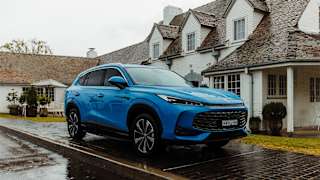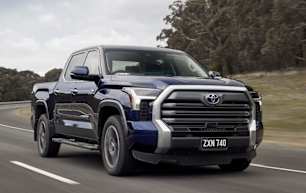The Tundra is imported to Australia as a left hand drive vehicle and converted on our shores by a company called Walkinshaw Automotive Group and they've done a great job on the Tundra, it really is quite impressive.
Steering is light and precise for such a big vehicle and off-the-mark acceleration is admirable for something so large.
The 10-speed automatic transmission is very cluey and the iFORCE MAX system – 3.5-litre twin-turbo V6, electric motor and battery – works seamlessly well. However, every now and again there's a bit of a clunky downshift – it’s the engine cutting out when you decelerate, or a slightly jarring transition from engine to motor and battery and back – but that's hardly a deal-breaker when the system otherwise works well.
The Tundra sits really well on the road or track because it is so big and it has such a long wheelbase and wide wheel track It's composed and confident and that makes driving the Tundra at speed on bitumen or on dirt or gravel in the bush, an easy, safe and comfortable experience.
But this ute’s shortcomings are quickly exposed once you try 4WDing in it.
It's not all lollipops and rainbows because this is a big vehicle and it has a massive 15m turning circle – and you really feel that in the bush when you get onto tighter tracks and more technical four-wheel driving.
The Tundra is simply not built for low-speed, low-range, off-roading, This big ute doesn't excel at those things because its size severely limits its capabilities. That's not to say it's terrible though, it's just not as comfortably capable in difficult 4WD scenarios as mid-size dual-cab utes are – those kinds of utes are more nimble, more manoeuvrable and more comfortable at home in those types of off-road situations than the Tundra is.
And because the Tundra has such a long wheelbase, it doesn't have a lot of ground clearance, a listed 216mm which is about standard for a full-size US ute, and that makes the Tundra’s undercarriage vulnerable to knocks and scrapes, no matter how innocuous the ruts or the moguls you are driving through may be.
The Tundra has the kind of off-road angles you’d expect for a vehicle this large: approach angle is listed as 23 degrees and departure angle is 21 (ramp-over is not listed).
Because the Tundra is so damn big you also tend to feel every bump and every pothole or rut when low-speed off-roading, whereas at higher speeds (upwards of 50km/h) on a formed track, it's nice and settled, it’s completely the opposite. When you take on challenging terrain at low speeds in the Tundra, it yields a wild and bouncy ride. And that's purely because, again, it's a bigger vehicle with a bigger wheelbase. I don't mind it – it’s a bit of fun – but some people may quickly grow tired of being thrown around inside the cabin.
The Tundra is let down by the fact it doesn't have any off-road driving modes, off-road traction control or diff locks. Sure, it has high- and low-range 4WD and a limited-slip diff, but it would certainly benefit from more help – especially lockers.
This ute’s standard tyres – Bridgestone Dueler H/T tyres (265/60R20) – are perfectly okay for light-duty four-wheel driving but fall well short when it comes to anything more difficult. Easy fix: get a full set of all-terrain tyres.
The Tundra’s payload is an underwhelming 758kg – for reference, the Chevrolet Silverado has a 757kg payload; the Ram 1500 (878kg) – but even dual-cab utes, such as the Ford Ranger (966kg kerb weight)/1010kg min kerb weight), offer better payloads. The F-150 Lariat LWB (710g) offers less.
Once you load in people, pets, camping gear, food, etc, then you've used up a lot of your payload capacity. And that's not to mention the fact that you may put aftermarket accessories on your Tundra – a bullbar, a roof rack, any of those sorts of things – and those reduce the amount of weight you can then throw in the Tundra.
Towing capacity is 750kg (unbraked) and 4500kg (braked) – with a 70mm towball. GVM is 3536kg and GCM is 7825kg.
Overall, the Tundra’s impressive on-road performance is enough to outweigh its 4WDing flaws.






